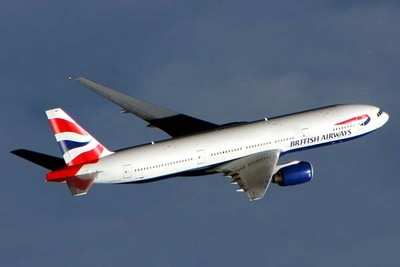Low Temps May Have Resulted In Ice Formation
Investigators into the January 17 downing of a British Airways
Boeing 777-236ER on approach to London's Heathrow Airport
reportedly suspect fuel-system contamination to be the cause... in
particular, the possibility ice formed in the fuel during the
airliner's flight from Beijing, resulting in fuel flow
blockage.

As ANN reported, the 777
landed short of runway 27L at Heathrow, after its two Rolls-Royce
Trent 895 turbofans failed to spool up in time to arrest the
airliner's descent. While 13 persons onboard the plane were injured
in the hard landing, there were no fatalities among the 152
persons onboard.
According to an update issued January 23 by the UK's Air
Accident Investigation Board, the 777's autothrust system commanded
an increase in thrust from both engines. Both engines initially
responded.. but after about three seconds the thrust of the right
engine reduced to just above flight-idle, with the left engine
following about eight seconds later.
The Wall Street Journal reports other factors for the aberration
remain under consideration... but FAA officials are increasingly
pointing towards some form of fuel contamination as the cause of
the accident -- specifically, "small-sized contamination building
up in the engine fuel systems" or "ice in the fuel somehow limiting
the fuel flow to the engines," according to a memo sent to
high-level FAA regulators last week.
So far, investigators have found no evidence of malfunctions to
the 777's computer systems, or the engines themselves... which
should come as something of a relief to Boeing, and operators of
the popular widebody airliner. Less comforting, though, is the
prospect of similar problems cropping up during other long-distance
flights -- especially on increasingly common polar routes, like the
accident flight.
 According to the FAA memo, the 777
encountered a "high humidity, cold environment, conducive to ice
formation" on its flight to Heathrow. Onboard sensors recorded a
fuel temperature at minus 34 degrees Celsius, or minus 29 degrees
Fahrenheit -- leading some investigators to theorize ice particles
formed in the fuel, and in turn impeded flow to the engines at the
critical time. Investigators also reportedly found internal damage
to at least one fuel pump on the 777, suggesting the pumps weren't
receiving adequate fuel flows, according to an anonymous source
close to the investigation.
According to the FAA memo, the 777
encountered a "high humidity, cold environment, conducive to ice
formation" on its flight to Heathrow. Onboard sensors recorded a
fuel temperature at minus 34 degrees Celsius, or minus 29 degrees
Fahrenheit -- leading some investigators to theorize ice particles
formed in the fuel, and in turn impeded flow to the engines at the
critical time. Investigators also reportedly found internal damage
to at least one fuel pump on the 777, suggesting the pumps weren't
receiving adequate fuel flows, according to an anonymous source
close to the investigation.
The memo also revealed possible hints of problems to come --
saying the pilots received "a maintenance message indicating
excessive water in the center tank" while taxiing for takeoff on
two flights prior to the accident flight. In each case, however,
the warnings disappeared before action was taken to address the
problem. The 777's center tank would have fed both engines on
descent and approach, according to experts cited by the WSJ.
Subsequent testing of fuel recovered onboard the accident
aircraft, as well as from other planes that refueled in Beijing
around the same time, showed the fuel met specifications.
A safety bulletin will be released by Boeing and UK aviation
officials in the coming days, updating 777 operators on the
investigation. Both US and British investigators say it's too soon
to issue specific recommendations to address potential center tank
icing, however.
 ANN's Daily Aero-Linx (05.06.25)
ANN's Daily Aero-Linx (05.06.25) ANN's Daily Aero-Term (05.06.25): Ultrahigh Frequency (UHF)
ANN's Daily Aero-Term (05.06.25): Ultrahigh Frequency (UHF) ANN FAQ: Q&A 101
ANN FAQ: Q&A 101 Classic Aero-TV: Virtual Reality Painting--PPG Leverages Technology for Training
Classic Aero-TV: Virtual Reality Painting--PPG Leverages Technology for Training Airborne 05.02.25: Joby Crewed Milestone, Diamond Club, Canadian Pilot Insurance
Airborne 05.02.25: Joby Crewed Milestone, Diamond Club, Canadian Pilot Insurance




